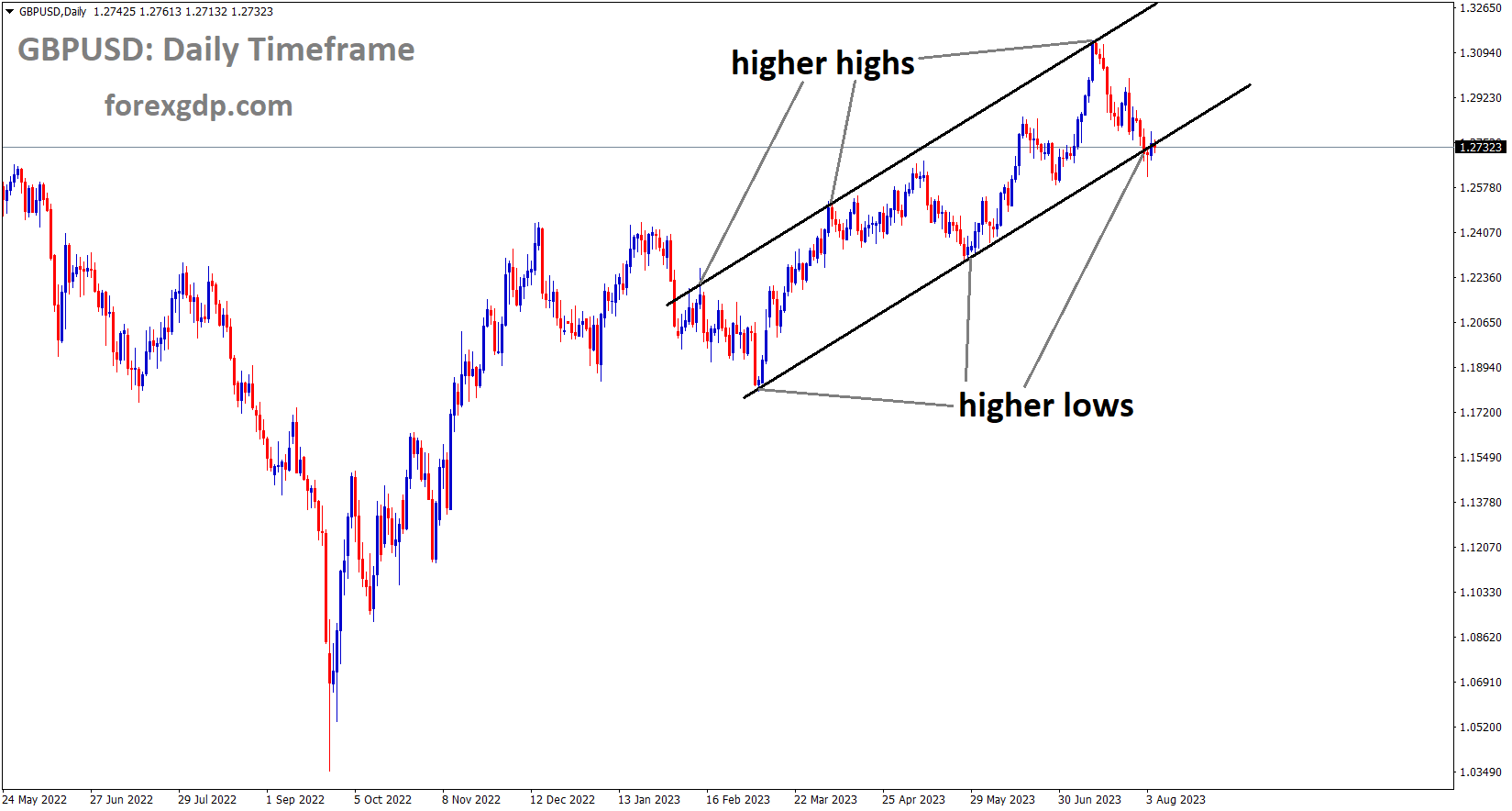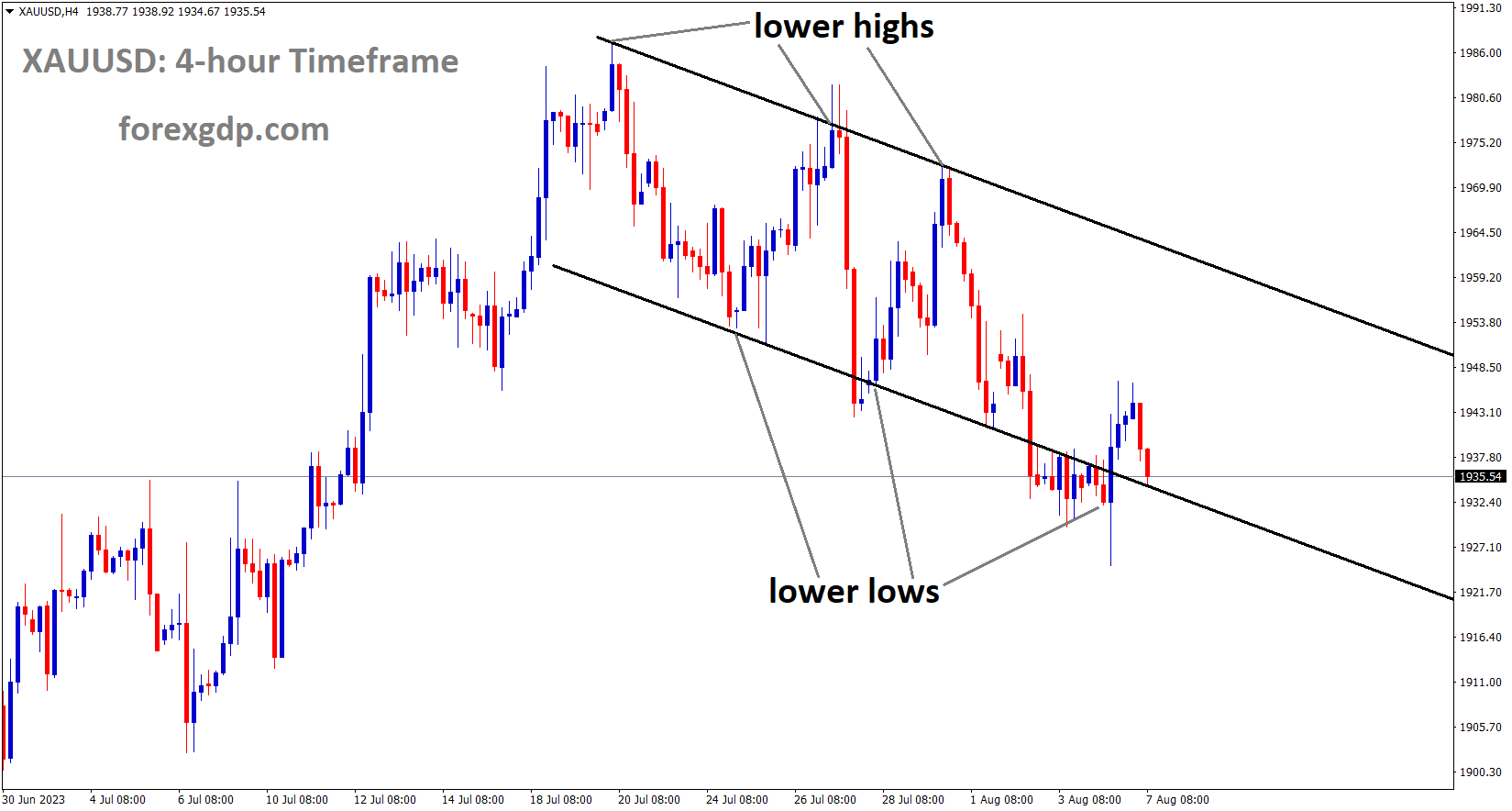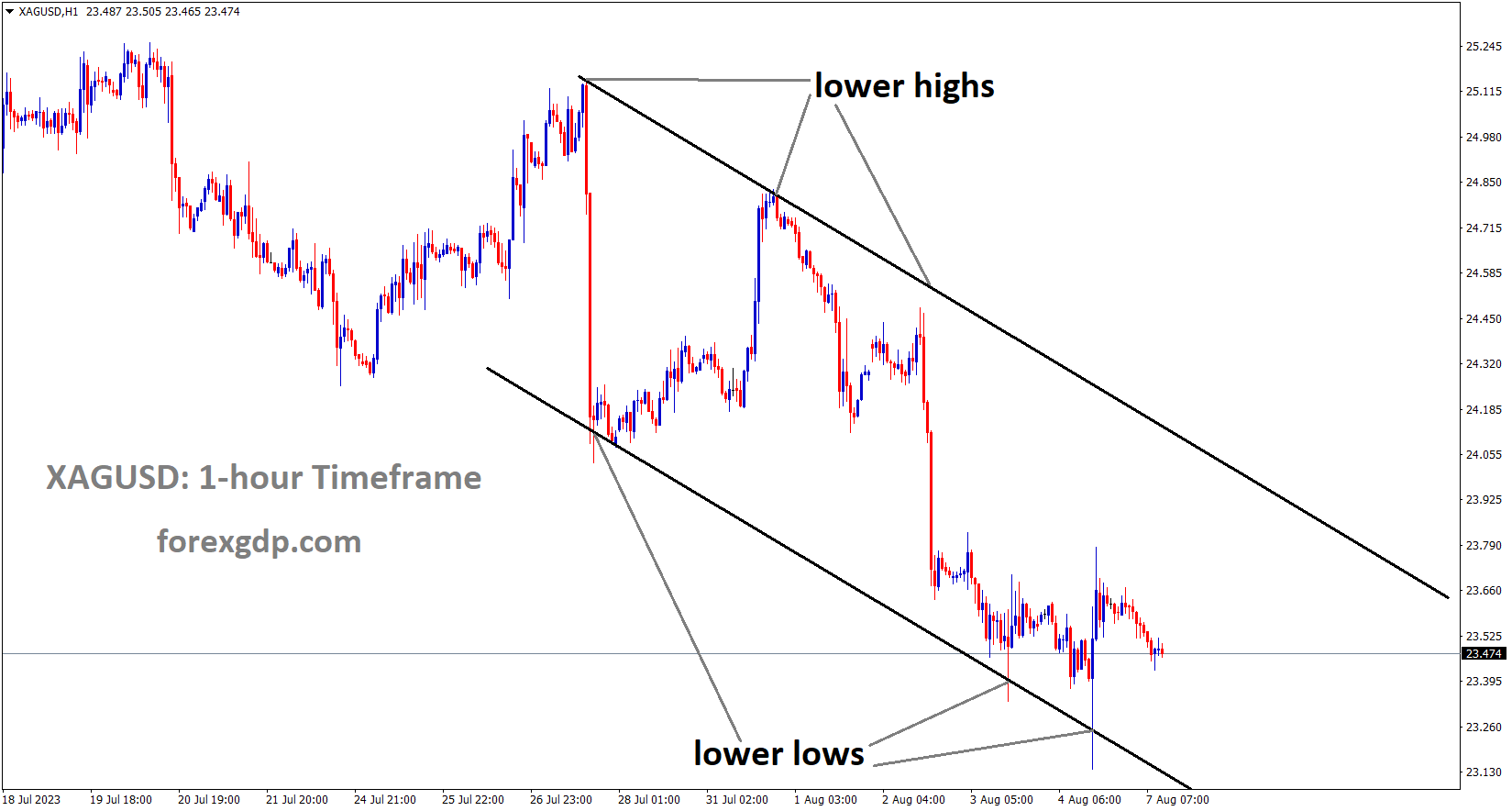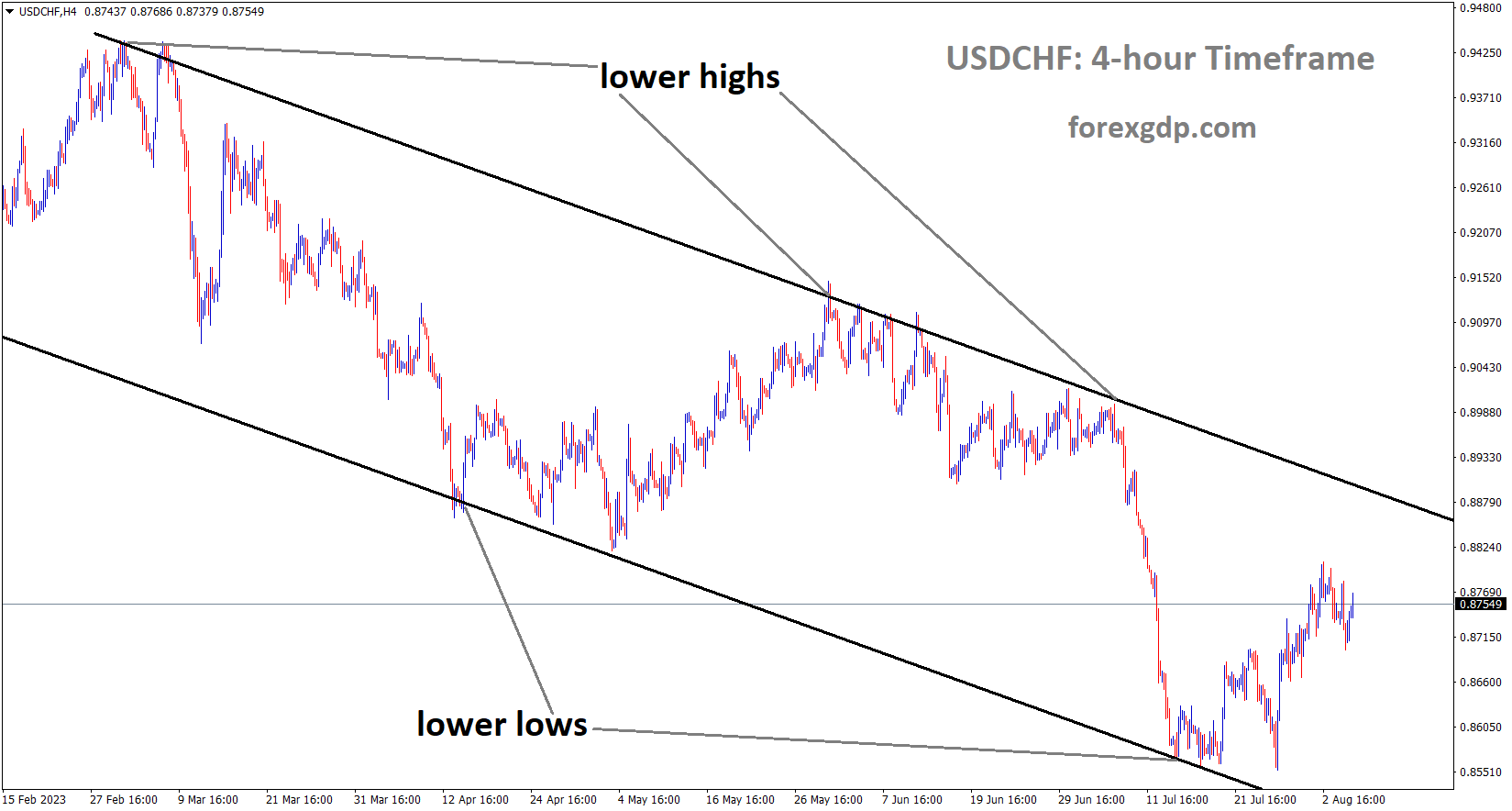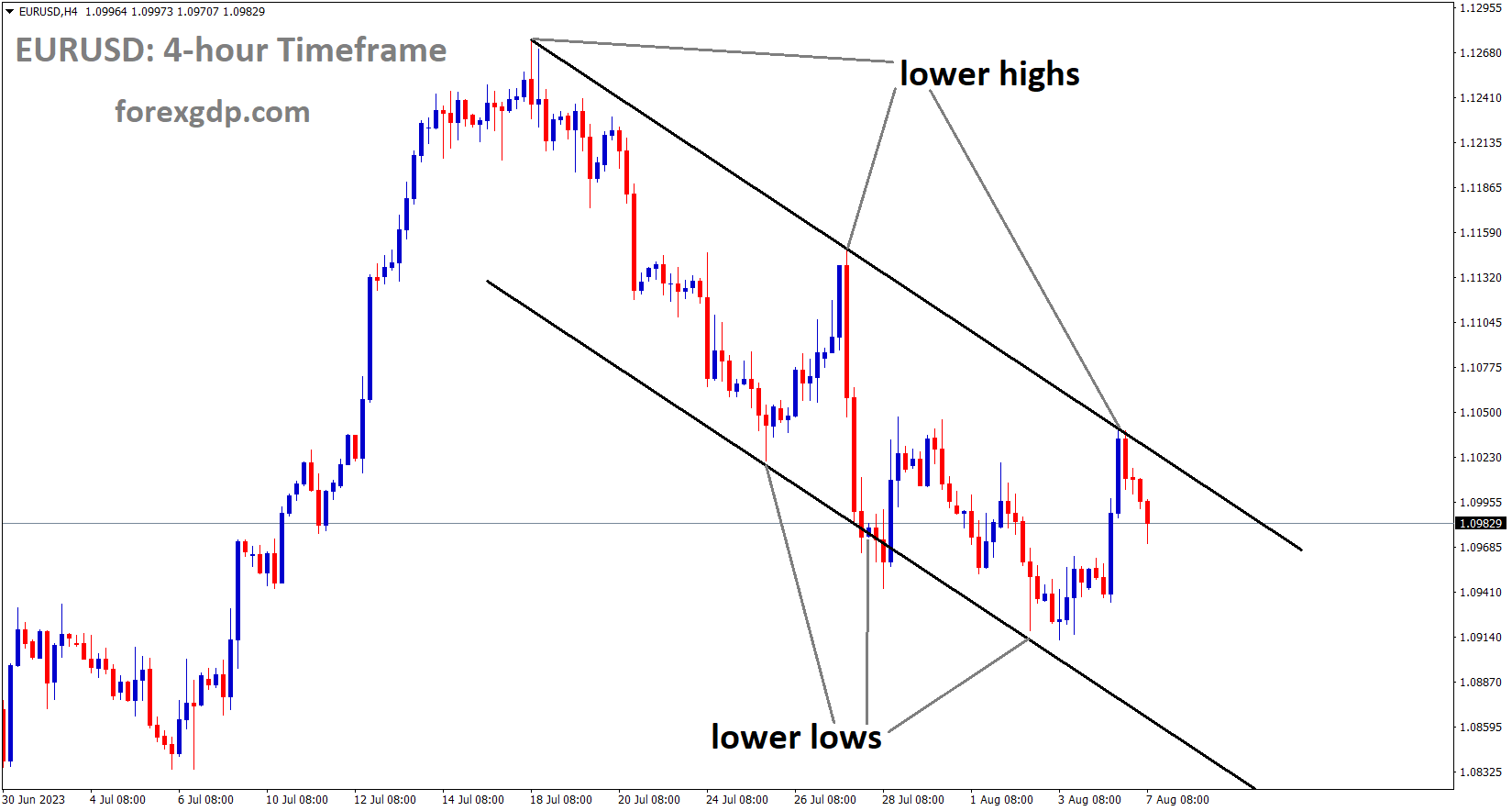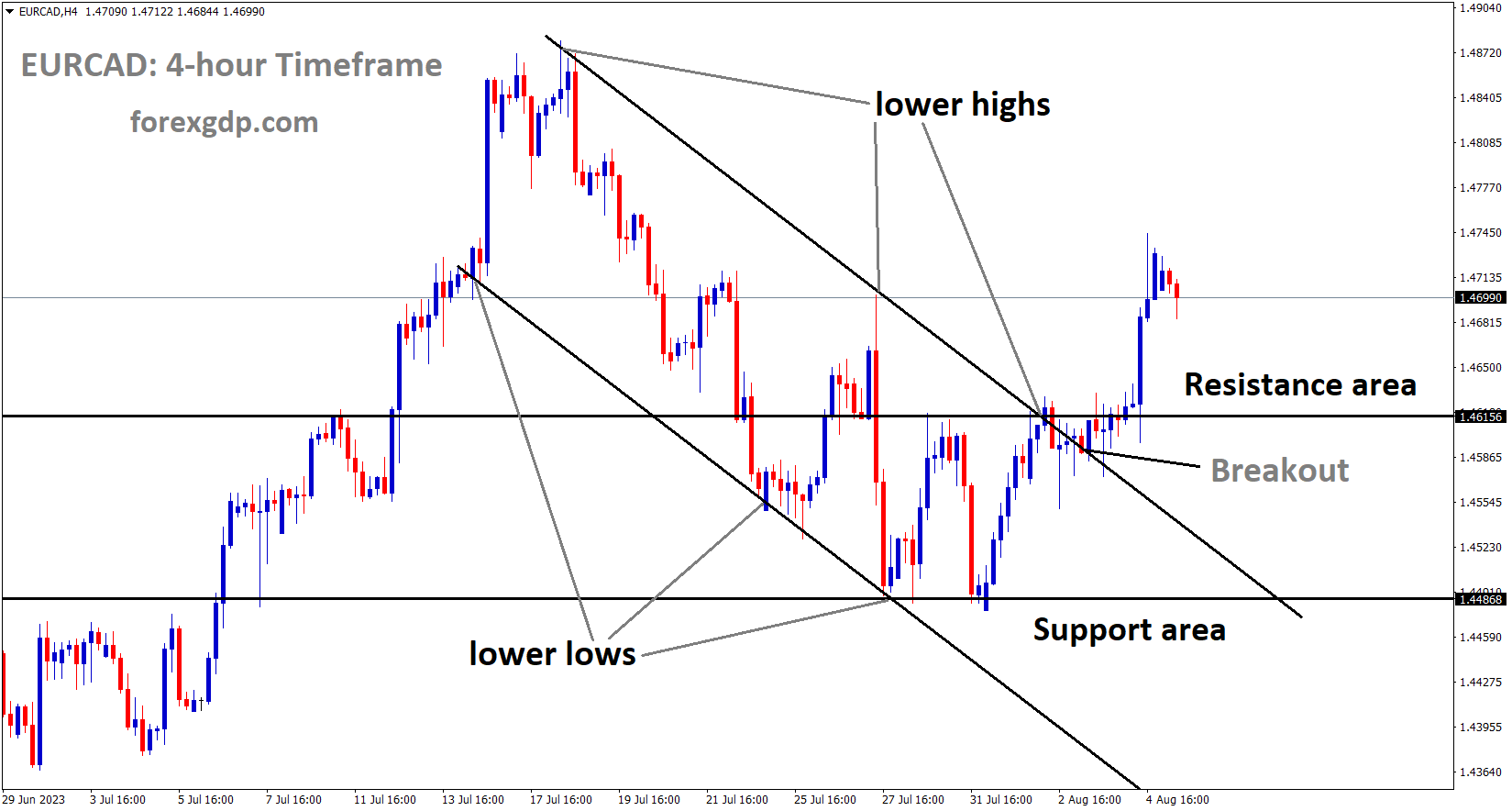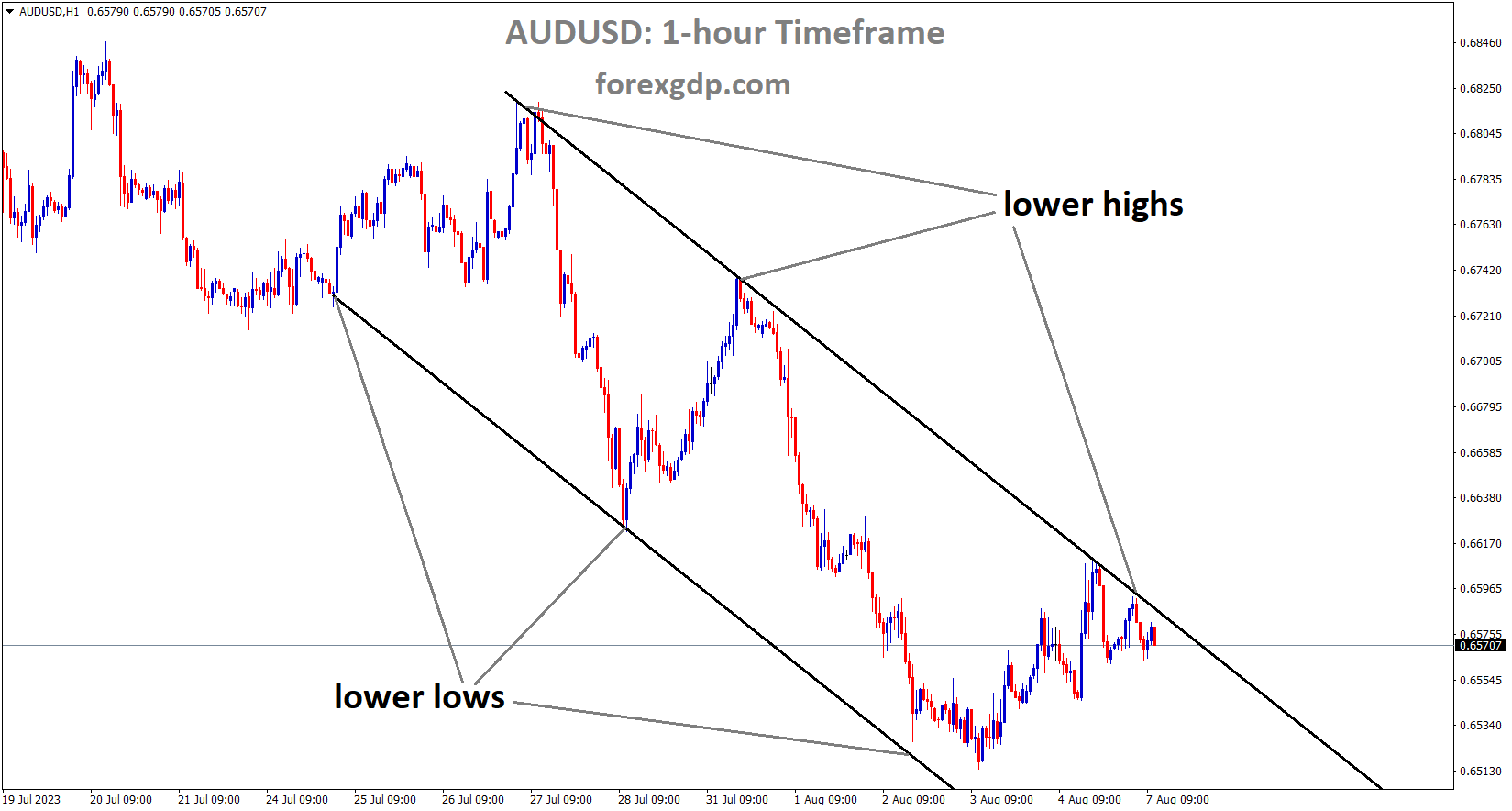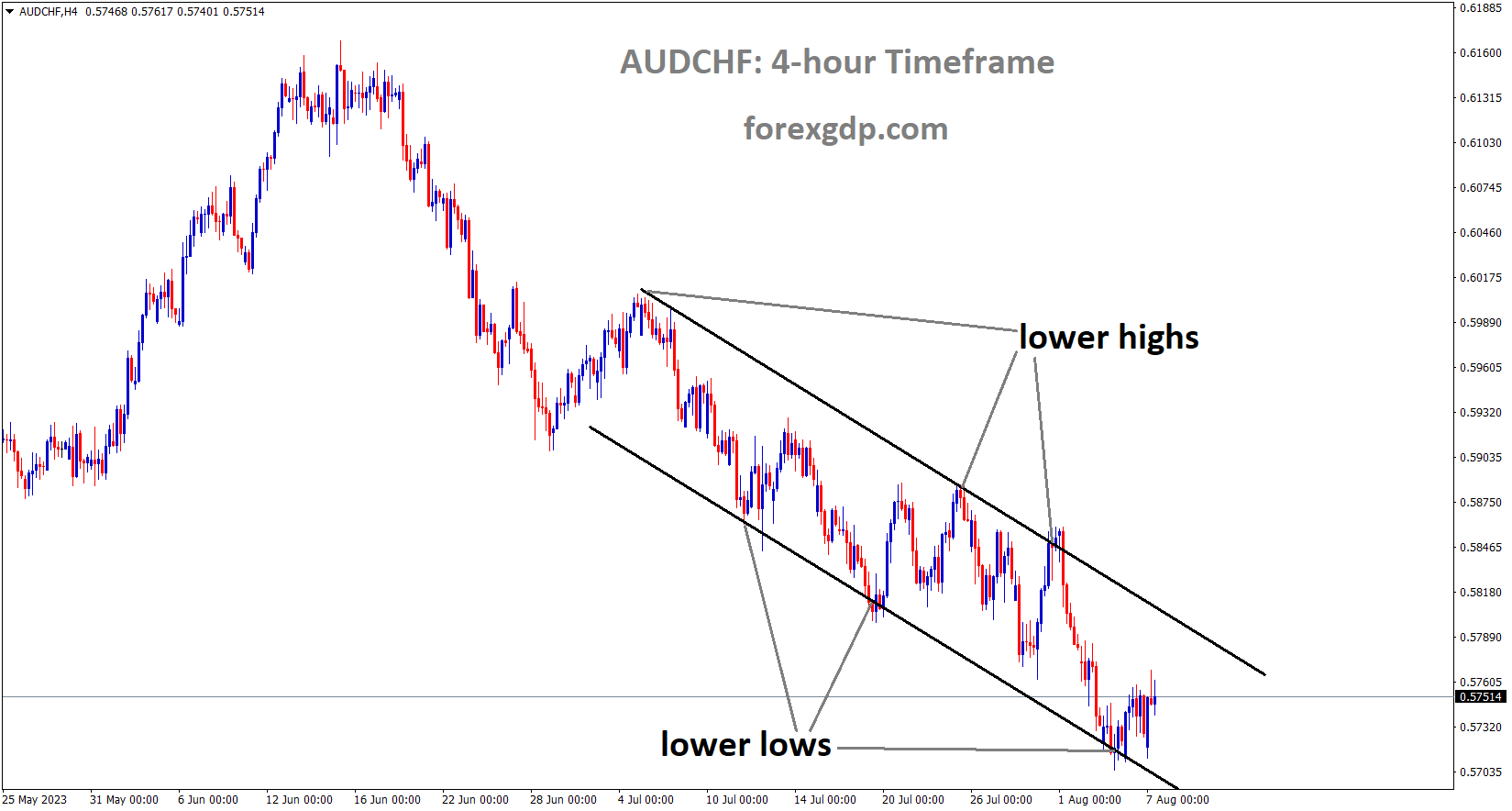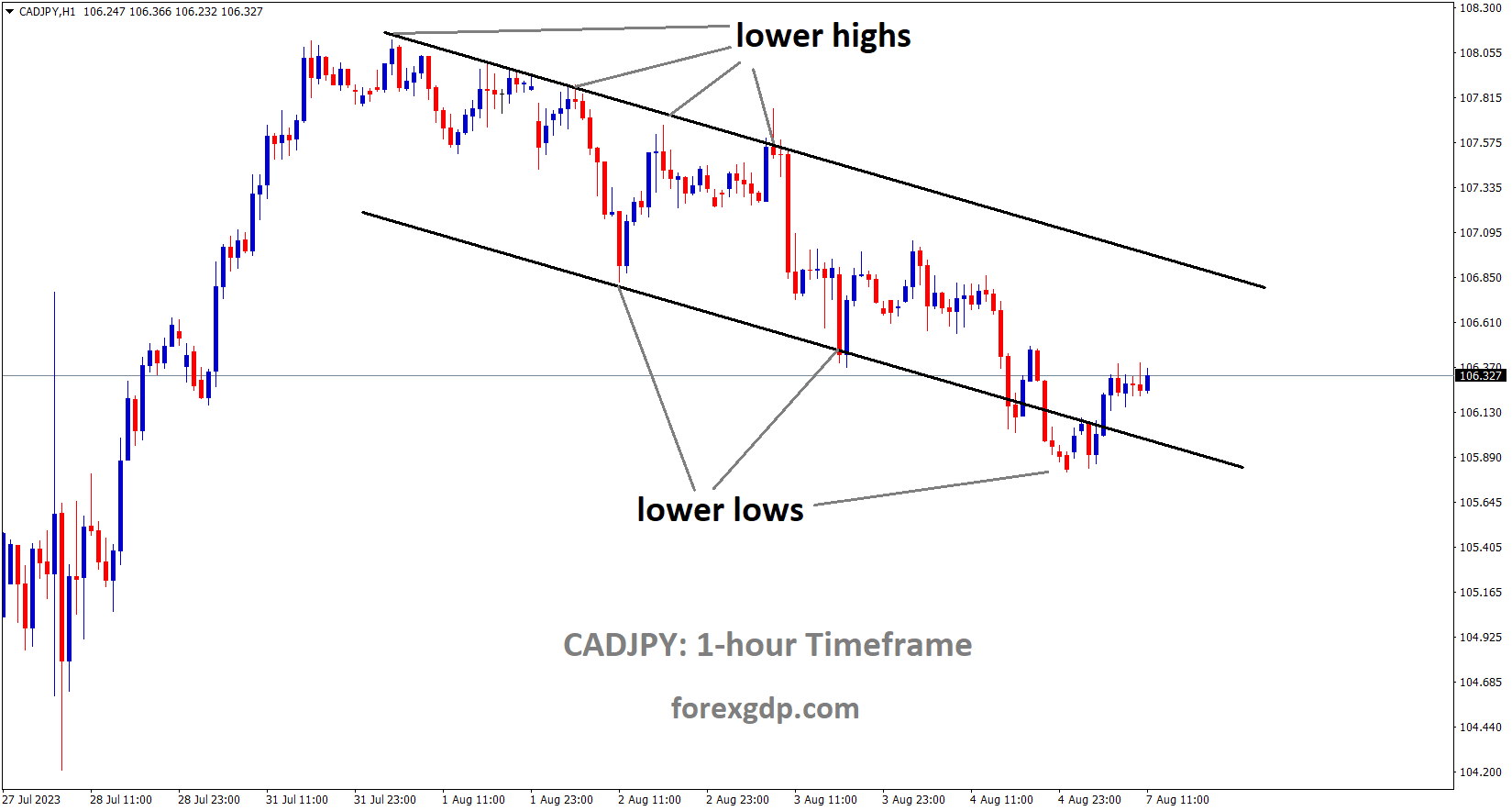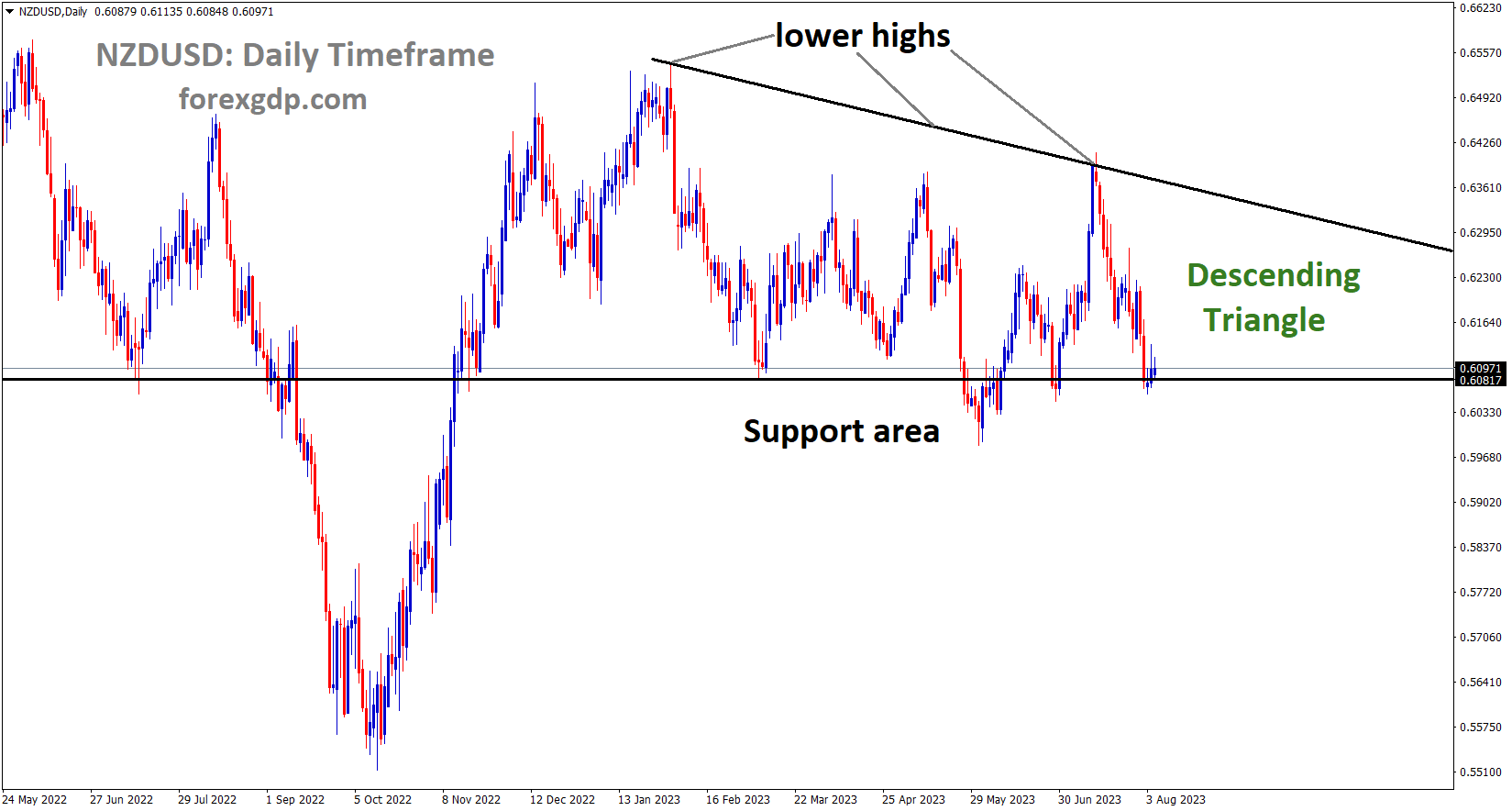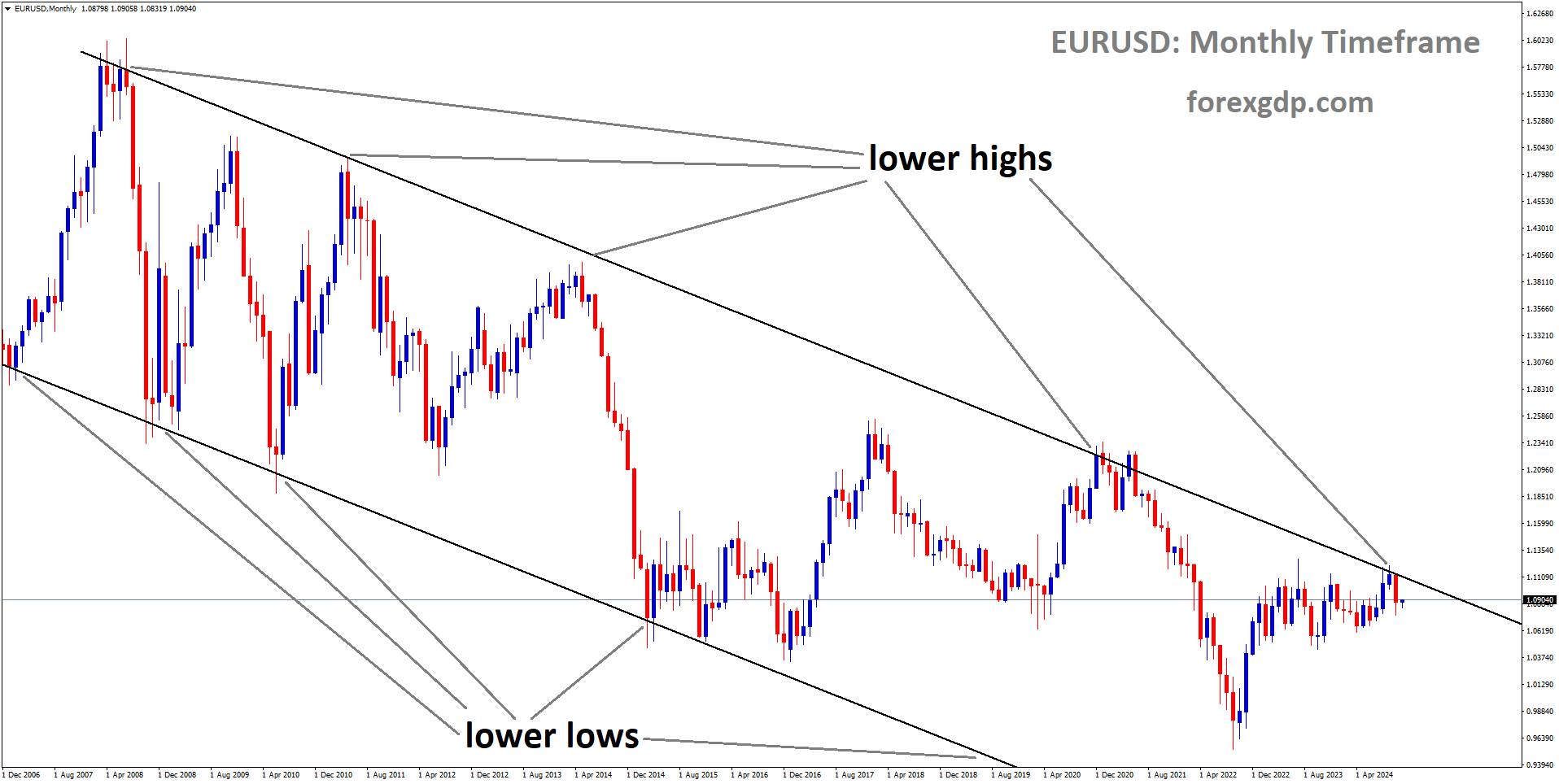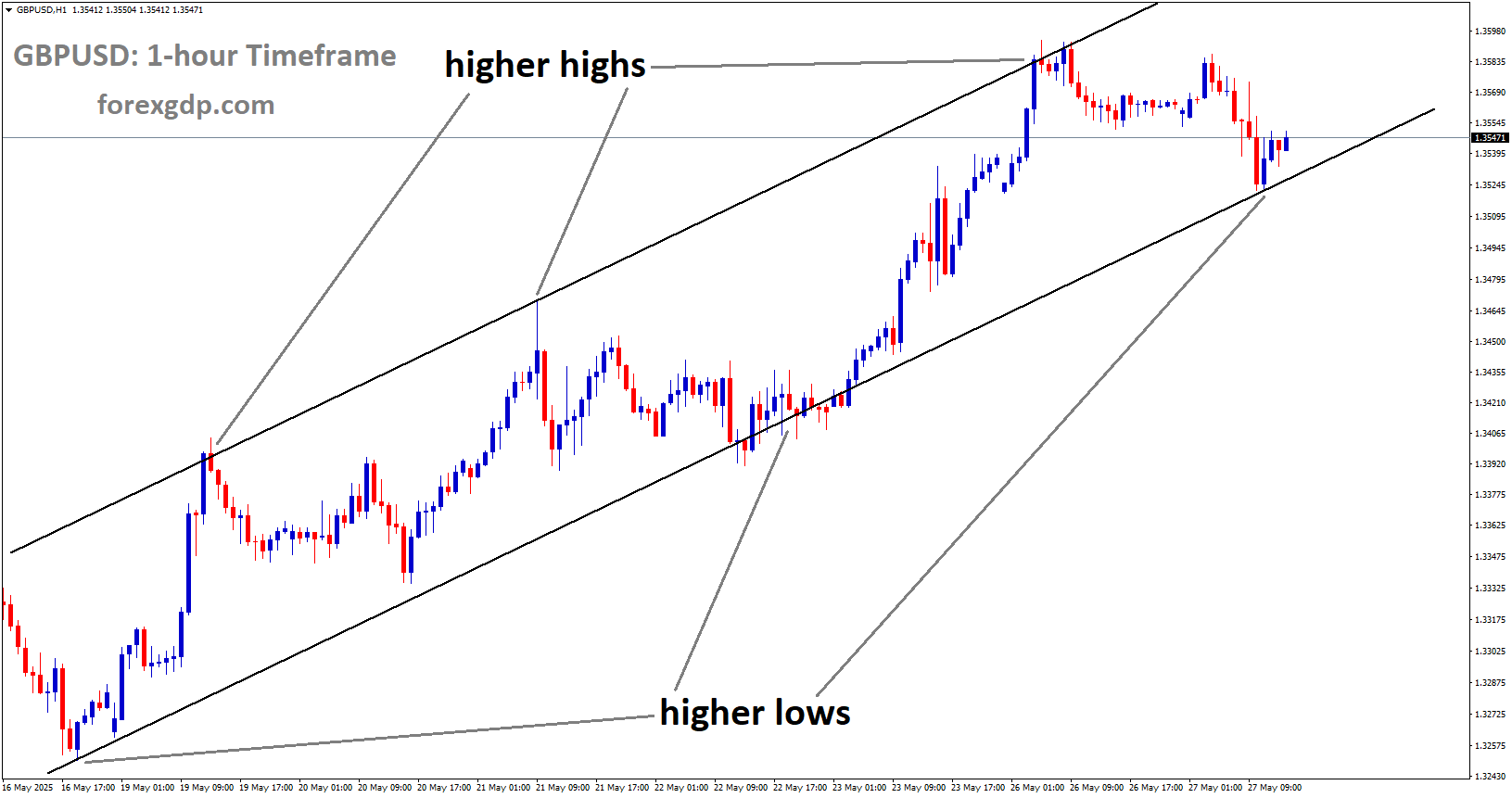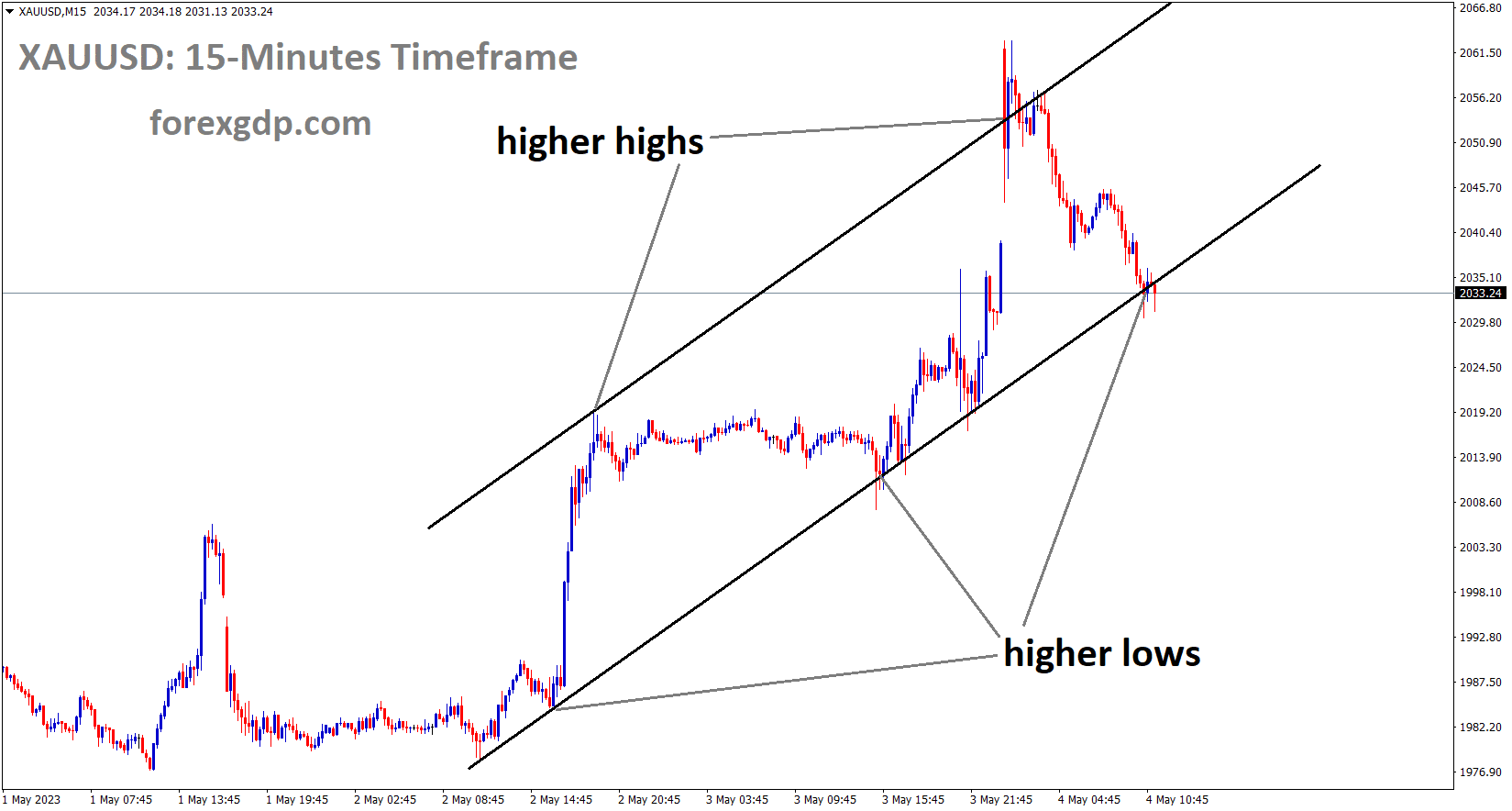GBPUSD Analysis
GBPUSD is moving in an Ascending channel and the market has reached the higher low area of the channel
GBP slipping against USD following The Bank of England raised interest rates last week by 25 basis points to 5.25%. By this October, the Bank of England will have reached its target inflation rate of 5% due to slower wage growth and inflation easing. Inflation will be more moderate than higher rates, UK Prime Minister Rishi Sunak has already pledged in his election manifesto. The Bank of England will achieve an inflation rate below 5% by year’s end.
The Bank of England BoE started escalating recession fears with higher interest rates, which caused the Pound Sterling GBP to decline after failing to test the key resistance level of 1.2800. The GBP/USD pair declines significantly as the outlook for the British economy is threatened by rising interest rates. Due to businesses slowing down their hiring procedures in the face of dim economic prospects, the UK’s robust labour market is losing some of its resilience. The BoE’s aggressive rate-tightening cycle has begun to have an impact on the UK housing market and its robust labour market, but it is also laying the groundwork for returning inflation to the target level of 2%. Andrew Bailey seems confident that because the central bank will keep interest rates “sufficiently restrictive for a sufficient period,” inflation will ease to 5% by October. The Pound Sterling plunges precipitously after failing to test the round-level resistance of 1.2800 as the Bank of England’s higher interest rates start to dim the outlook for the economy. The outlook for the UK’s economy is being closely watched as BoE policymakers leave the door open for additional policy tightening. The Bank of England increased interest rates by 25 basis points bps to 5.25% last week. In the current tightening cycle, this was the 14th consecutive rate increase, making interest rates the highest they have been in 15 years. Last week, Governor of the Bank of England Andrew Bailey stated that the central bank would maintain interest rates at “sufficiently restrictive levels for a sufficient period” in order to ensure that inflation quickly returns to 2%.
That UK Prime Minister Rishi Sunak would keep his promise to halve inflation this year is indicated by Andrew Bailey’s apparent confidence that inflation will fall to 5% in October. Sunak made the promise when inflation was in the double digits. After the BoE announced its monetary policy, chief economist Huw Pill stated that the labour market is cooling and inflationary pressures are easing as a result of ongoing interest rate hikes. He continued by saying that over time, lower wage growth would result from higher unemployment and fewer job openings. The housing market and labour market are under increasing stress as a result of the central bank’s aggressive tightening cycle. According to a survey by the Recruitment & Employment Confederation REC and KPMG, UK businesses slowed down hiring permanent staff last month by the most since mid-2020 as a result of growing concerns about the economy, Reuters reported. REC Chief Executive Neil Carberry claimed that despite the slowdown in permanent placements, the labour market was still “fairly robust.”As first-time homebuyers delay their plans to purchase homes in order to avoid paying higher interest rates, the housing market continues to be fragile. As investors wait for the July inflation data for the United States, which will be released on Thursday, the market is in a cautious mood.
As Federal Reserve Fed policymakers continue to believe that additional interest rate increases will eventually cause inflation to reach 2%, the US Dollar Index DXY rises above 100.00. Michelle Bowman, the governor of the Federal Reserve, stated over the weekend that the US central bank will increase interest rates even more to reduce inflation. She continued by saying that she was in favour of further tightening of policy in July due to strong consumer spending, a tight labour market, and persistently high inflation. The central bank will likely continue to be restrictive in 2024, according to Raphael Bostic, president of the Atlanta Fed Bank. Regarding the labour market, the Fed policymaker stated that July’s employment remained consistent with forecasts and that he is not surprised by the continued strength of wage growth. In the US Nonfarm Payrolls NFP report released last week, new employment increased by 187K, slightly exceeding June’s reading of 185K but falling short of expectations of 200K. Compared to predictions and the previous release of 3.6%, the unemployment rate decreased to 3.5%. Investors expected the economic data to decline to 0.3%, but the monthly labour cost index maintained its pace of 0.4% from June. In addition, the annualised labour cost index held steady at 4.4% versus the forecasted level of 4.2%.
GOLD Analysis
XAUUSD Gold price is moving in the Descending channel and the market has reached the lower low area of the channel
Following Friday’s NFP data printing at a slightly lower than anticipated level, gold prices have decreased. The US domestic data were mixed, which made the US Dollar more powerful than Gold. US Q2 GDP increased, pushing the dollar higher last week than gold.
Gold Price XAUUSD defends the previous day’s corrective bounce off an important support line, mainly backed by mixed US employment report, during early Monday in Asia, and starts the week comprising the important United States inflation without many surprises. As a result, the XAUUSD oscillates around $1,943, flirting by the time of publication with the 50-DMA barrier. However, the US Dollar Index DXY managed to post a three-week uptrend despite mixed data and easing concerns about the Federal Reserve’s Fed rate hike in September, while the Gold Price fell in the last two consecutive weeks, marking the biggest weekly loss since mid-June. The cause might be the current wave of risk aversion, which is primarily supported by Fitch Ratings’ downgrading of the US credit rating. As a result, the US inflation data this week, specifically the Consumer Price Index CPI and Producer Price Index PPI for July, are generating more excitement among gold traders. Unimpressive US data were overshadowed by the market’s risk-off stance, which led to the US Dollar posting a three-week winning streak. This put downward pressure on the Gold Price despite Friday’s corrective bounce. In terms of the numbers, the headline employment report showed a lower-than-expected Nonfarm Payrolls NFP figure of 187K compared to 185K prior revised and 200K market forecasts, while the Unemployment Rate decreased to 3.5% from 3.6% expected and previous readings. Additionally, the Average Hourly Earnings surpassed forecasts for a slight slowdown in wage growth by printing 0.4% MoM and 4.4% YoY numbers.
SILVER Analysis
XAGUSD Silver Price is moving in the Descending channel and the market has rebounded from the lower low area of the channel
It is also noteworthy that while the July ISM Services PMI declined, the month’s more significant Manufacturing PMI showed a slight improvement. Additionally, the second-tier employment-related data, such as Nonfarm Productivity and JOLT Job Openings, showed a slight increase in June for US Factory Orders. The Q2 Unit Labour Cost, however, eased and deteriorated favouring the Fed’s rate hike in September. The preferred inflation gauge of the Federal Reserve Fed began to decline earlier in July, but the US Gross Domestic Product GDP Annualised for the second quarter Q2 still managed to dazzle with encouraging growth rates.According to the CME’s FedWatch Tool, the market’s expectations for the Fed’s September rate hike decreased from 20.0% to 13% on a weekly basis. In light of this, Raphael Bostic, president of the Atlanta Federal Reserve Bank, told Bloomberg on Friday that the central bank is likely to maintain its monetary policy in a restrictive range well into 2024.
Austan Goolsbee, President of the Chicago Fed, on the other hand, said that they should begin debating how long to hold rates. As a result, the majority of US statistics have been contradictory and may not be the main cause of the rise in the US Dollar Index DXY, which in turn draws attention to Fitch Ratings’ downgrade of the US credit rating from AAA to AA+. The US-China tension and mixed corporate earnings from US corporate giants combine with the same to depress sentiment and the price of gold. Despite challenges from mixed emotions, the gold price was able to recover thanks to significant support, a decline in Friday’s US Nonfarm Payrolls NFP, consolidation of the previous week’s stock market losses, and these factors. Additionally, a decline in US 10-year Treasury bond yields from their yearly high assisted in the XAUUSD’s recovery without the need for noticeably negative US data. Therefore, gold traders will pay attention to this week’s United States inflation hints for July provided by the CPI, PPI, and inflation expectations from the University of Michigan. The Gold Price may increase further towards the crucial $1,960 barrier if the planned data point to easing price pressure in the largest economy in the world.
USDCHF Analysis
USDCHF is moving in the Descending channel and the market has rebounded from the lower low area of the channel
Semiconductors, artificial intelligence, and other key goods that China consumes more of are anticipated to be subject to tariffs from US President Joe Biden. The Swiss Franc gained from these tensions when compared to other currency pairs.
During the early Asian session on Monday, the USD/CHF pair regains some lost ground and soars above the 0.8740 level. The US Dollar Index (DXY), a gauge of the USD’s value against six other significant currencies, has since rebounded off the 101.75 level and is currently trading close to 102.05. Following the Friday release of the July employment and wage inflation report, the US dollar came under some selling pressure. Despite this, the US Bureau of Labour Statistics (BLS) announced on Friday that US Nonfarm Payrolls increased by 187,000 in July. This result fell short of the 200,000 market expectation. The June figures were reduced to a reading of 185,000, which is the lowest number since December 2020. Additionally, the unemployment rate decreased from 3.6% to 3.5%, and annual wage inflation, as determined by changes in average hourly earnings, was higher than expected at 4.4%. While the U6 Unemployment Rate decreased to 6.7%, the labour force participation rate remained constant at 62.6%. The conflicting readings had no impact on economists’ expectations for the Federal Reserve’s policy. But that would depend on how inflation develops. The likelihood of a 25 basis point (bps) hike in September remains constant, but the odds of a hike in November have increased slightly to around 30%, according to the CME FedWatch tool.
Investors, however, will pay close attention to the US-China relationship. In order to limit US investments in China in the high-tech industry, artificial intelligence, semiconductors, and quantum computing, US President Joe Biden is reportedly planning to issue an executive order this week, according to Reuters. The Swiss Franc may gain from the heightened tensions between the world’s two largest economies while the USD/CHF exchange rate may suffer. Market participants will now pay attention to the Swiss Employment Rate, which is due later on Monday. The percentage is anticipated to stay at 2.0%. The US Consumer Price Index (CPI) for July is scheduled to be released on Thursday. Market projections call for a monthly increase of 0.2%. On Friday, the US Produce Price Index (PPI) will also be made public. Participants in the market will monitor the data and look for trading opportunities surrounding the USD/CHF pair.
EURUSD Analysis
EURUSD is moving in the Descending channel and the market has fallen from the lower high area of the channel
German industrial production for the month of June came in at -1.5%, which is a worse reading than the -0.40% anticipated and the -0.10% prior reading.
The ECB may raise rates as a result of the peak in inflation readings in the first half of 2023, according to Fitch ratings.
The non-seasonally adjusted figures showed a 1.7% decline in German IP compared to 0.0% previous readings, the MoM figures for June showed a -1.5% decline in German IP, down from -0.4% expected and -0.1% prior. The Euro has been holding its ground against the GBP despite softer inflation data prints in the Eurozone over the past week due to an improvement in the region’s growth statistics. On the other hand, the global rating agency Fitch Ratings, which stated on Friday that the declining Eurozone inflation puts the ECB rates peak within sight, set off the rumour mill regarding the peak rates of the European Central Bank ECB. The ECB article on the same subject claimed that underlying inflation likely peaked in the first half of 2023.
EURCAD Analysis
EURCAD has broken the Descending channel in upside
Canadian employment changed by -6.4K in July, lower than the expected 21.1K and the 59.4K reading that was published on Friday of the previous week.
After the employment change was less than anticipated, the unemployment rate increased slightly from 5.4% to 5.5%.
The Loonie pair also explains the recent decline in the price of WTI crude oil, which is Canada’s main export good. WTI crude oil recently dropped to $82.30 after reaching a two-month high near $83. The talk of a supply shortage caused by Saudi Arabia and Russia combined with the decision by OPEC+ to maintain output cuts drive up the price of oil. The latest worries about China’s typhoon Doksuri, however, have a negative impact on the price of black gold. The Loonie pair, on the other hand, had a better chance of remaining on the bull’s radar The firmer Oil price has recently capped the Loonie pair’s recent run-up. Canada’s headline Net Change in Employment fell to -6.4K in July, down from 59.9K in June and 21.1K market forecasts, while the Unemployment Rate increased to 5.5%, matching forecasts, from 5.4% in June.
AUDUSD Analysis
AUDUSD is moving in the Descending channel and the market has reached the lower high area of the channel
The anti-dumping and anti-subsidy tariffs on imports of Australian barley have been lifted, according to a statement from China’s ministry of commerce. Caixin manufacturing services in China increased to 54.1 from 53.9 for the month of July, benefiting the Australian Dollar.
The AUDUSD pair starts the new week off well and picks up steam near 0.6575 on Monday during the Asian session. The softer US employment data released on Friday helps to explain the increase in the Australian dollar. According to a report released on Friday by the US Bureau of Labour Statistics BLS, nonfarm payroll growth in the US rose 187,000 in July, which was worse than anticipated by 200,000. The numbers for June were decreased to 185,000. Since December 2020, this reading has been at its lowest level. In the meantime, the unemployment rate decreased from 3.6% to 3.5%. The annual wage inflation rate was 4.4%, higher than the market expectation of 4.2%, as determined by changes in average hourly earnings. Last but not least, the labour force participation rate stayed the same at 62.6%. The weaker data pointed to a sluggish US labour market, which might persuade the Federal Reserve Fed to lower interest rates and limit USD appreciation. Phillip Lowe, Governor of the Reserve Bank of Australia RBA, said that the decision to maintain rates gives the RBA more time to assess the effects of the interest rate hikes and the outlook for the economy. To ensure that inflation returns to target in a reasonable amount of time, more monetary policy tightening might be required, but this will depend on the data and the evolving risk assessment.
AUDCHF Analysis
AUDCHF is moving in the Descending channel and the market has rebounded from the lower low area of the channel
The Australian Bureau of Statistics ABS revealed last week that the Australian Trade Balance was A$11,321M, just a little less than the A$11.791M recorded in May. Due to a decrease in China’s demand for commodities, shipments of metals, coal, and other mineral fuels all saw a 2% decrease in volume. However, a 4% decrease in imports in May more than made up for the decline in exports. Retail Sales QoQ, meanwhile, decreased from -0.6% to -0.5%. Additionally, as of August 5, China will remove its anti-dumping and anti-subsidy tariffs on imports of Australian barley, according to news released on Friday by the Chinese Ministry of Commerce. In turn, this strengthens the Australian Dollar relative to its rivals. It is important to note that China’s Caixin Services PMI increased from 53.9 to 54.1 in July, beating the market consensus of 52.5. The Australian Dollar AUD, a proxy for China’s currency, may also profit from the positive Chinese economic data. Due to the absence of the Australian economic data release on the bank holiday, market participants will analyse the data on Friday. Wednesday’s Consumer Price Index CPI YoY for China will be the focus. Also due later this week are the July US Consumer Price Index CPI and Produce Price Index PPI. Market participants predict that the US CPI will rise by 0.2% each month. In order to forecast a clear movement for the AUDUSD pair, the data will be essential.
CADJPY Analysis
CADJPY is moving in the Descending channel and the market has rebounded from the lower low area of the channel
One member of the Bank of Japan’s Summary of Opinions meeting last week stated that sustainable inflation of 2% is to be attained in the upcoming months. Another participant stated that proper monetary easing measures must be used to manage YCC Yield curve control. BoJ stated that they must communicate to the public what their goals are and how they plan to achieve sustainable inflation.
The BoJ decision, according to the government, will be appropriate and advantageous to both the government and the general public.
According to the Summary of Opinions for the Bank of Japan (BoJ) monetary policy meeting held in July, one member stated that the achievement of 2% inflation in a sustainable and stable manner “seems to have clearly come in sight.” One member was also quoted in the BoJ Summary of Opinions for July as suggesting that the bank conduct Yield Curve Control (YCC) with more adaptability and make plans in order to successfully continue with monetary easing while swiftly responding to both upside and downside risks.
As stated in the Summary of Opinions, the Japanese Ministry of Finance Representative also stated that the BoJ must carefully explain to the public its intention regarding the changes proposed at this meeting. According to the Summary of Opinions distributed by Reuters, the Cabinet Office Representative also stated, Government expects BoJ to conduct appropriate monetary policy towards achieving price stability target in a sustainable and stable manner while closely cooperating with them.
NZDUSD Analysis
NZDUSD is moving in the Descending triangle pattern and the market has reached the horizontal support area of the pattern
After the New Zealand Employment Change (QoQ) came in at 1.0% better than 0.50% expected and 0.80% previously last week, the NZD Dollar fell against the USD. The unemployment rate also increased to 3.6% from 3.4% previously and 3.5% expected.
Lower employment conditions and wage growth result from rising interest rates from the RBNZ, and the aim of bringing inflation down is now more focused.
In the early Asian session on Monday, the NZDUSD pair fluctuates within a constrained range beneath the 0.6100 level. The US Dollar Index DXY, which measures the value of the USD against six other significant currencies, is currently trading close to 10205 and is facing some follow-through selling. Following Friday’s conflicting employment data, the US dollar declined. In contrast to the market’s expectation of 200,000, the US Bureau of Labour Statistics BLS reported on Friday that nonfarm payrolls increased by only 187,000 in the US in July. The June figures were reduced to a reading of 185,000, which is the lowest number since December 2020. The unemployment rate decreased from 3.6% to 3.5%, and annual wage inflation, as determined by changes in average hourly earnings, was higher than expected at 4.4%. Last but not least, the labour force participation rate stayed the same at 62.6%. Raphael Bostic, president of the Atlanta Federal Reserve Bank, told Bloomberg on Friday that the central bank is likely to continue tightening monetary policy well after 2024. The likelihood of a 25 basis point bps hike in September remains constant, but the odds of a hike in November have increased slightly to around 30%, according to the CME FedWatch tool.
No significant economic data for New Zealand was made public on Friday. Nevertheless, Statistics New Zealand revealed on Wednesday that the country’s Q2 unemployment rate was 3.6%, higher than the expected 3.5% and 3.4%. Employment Change QoQ increased 1.0%, exceeding expectations of 0.5% and 0.8%, respectively. Market participants will be keeping an eye on Thursday’s release of the US Consumer Price Index CPI for July. Market projections call for a monthly increase of 0.2%. On Friday, the US Produce Price Index PPI will also be made public. The US Dollar’s dynamics may be significantly impacted by the inflation data, which may also provide the NZDUSD pair with a clear direction.
Don’t trade all the time, trade forex only at the confirmed trade setups.
Get Live Free Signals now: forexgdp.com/forex-signals/

